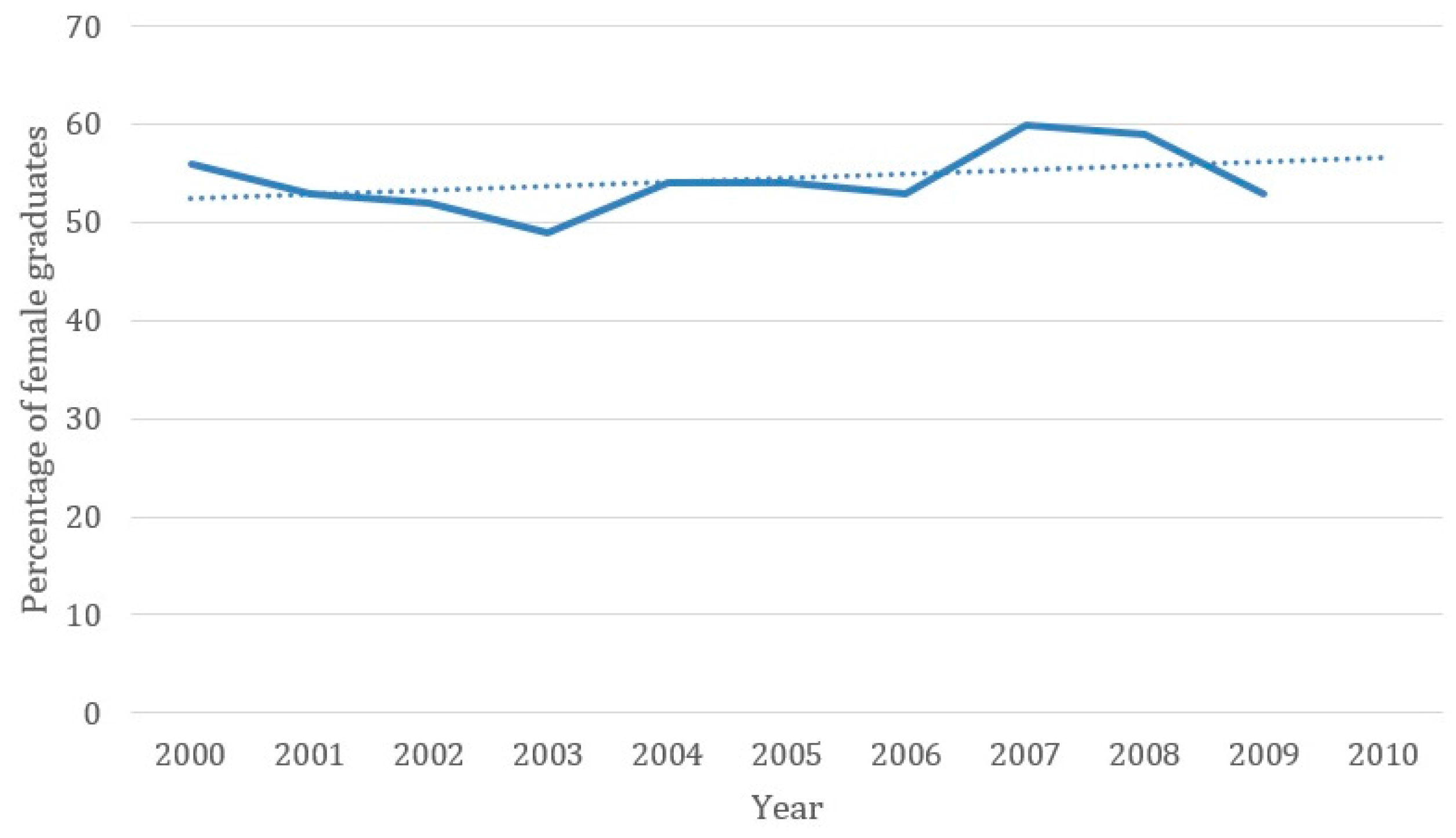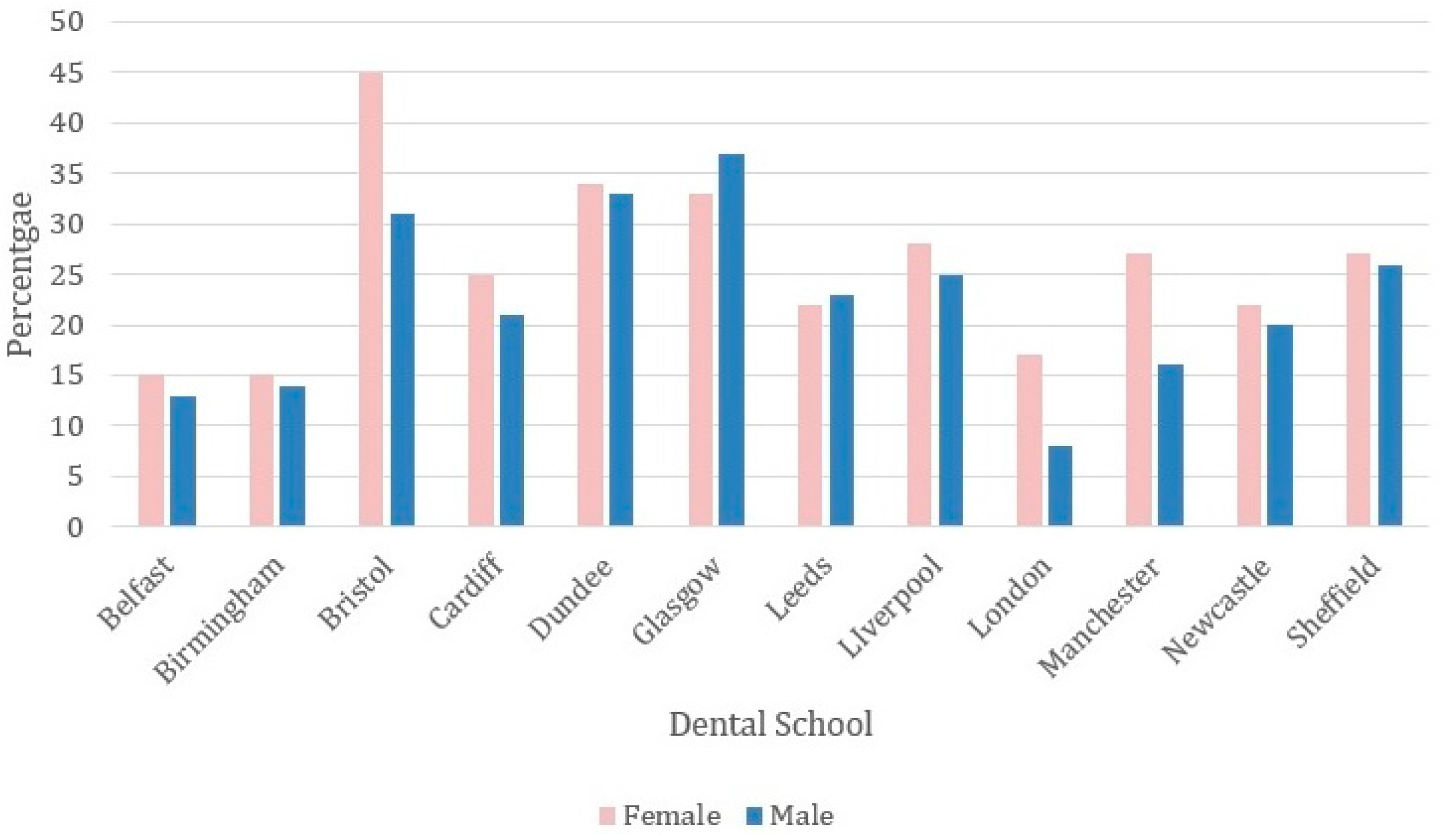This study provides objective data on postgraduate qualifications obtained by UK dentists who qualified between 2000 and 2009. There was a large range (12% to 39%) in the proportion of 2000 to 2004 graduates who undertook postgraduate qualifications from each of the 12 dental schools offering dentistry as an undergraduate degree during the period of study. Bristol had the highest overall proportion, and also the highest proportion of females completing postgraduate study. It appears that Bristol provides an undergraduate education that encourages further learning, possibly as a result of a high exposure to different specialties and the influence of specialist staff whilst an undergraduate. The reasons for this variation between schools are unclear and warrants further study, as it would be expected that undergraduates at all UK schools are exposed to different specialties. During the period 2004 to 2009, further dental schools opened within the UK, although graduates from these newer schools would not have been on the GDC register until 2010. Furthermore, it is not known if the dentists who undertook these postgraduate qualifications remain on the dental register as some may have retired, moved abroad or left dentistry altogether.
The fact that nearly one-quarter (24%) overall of all UK female graduates go on to undertake further study is noteworthy, considering that postgraduate education usually takes place during the childbearing years of a woman’s life. This trend for increasing numbers of female dentists to undertake formal postgraduate qualifications has been previously been reported overseas. A study conducted in Saudi Arabia [
14] found that 54% of female respondents had completed formal postgraduate education. Over one-half (58%) of these females had a Master’s degree, and 45% of these were obtained abroad. Most women complete postgraduate training before starting a family, whereas men are more inclined to have children prior to or during postgraduate study [
9]. Our own study supports the previous findings that newly qualified female dentists are undertaking postgraduate study early in their professional careers, possibly prioritising careers over family. The reasons for the variation between schools of the proportion of female graduates undertaking a postgraduate qualification are unknown and warrants further research. It is also evident that an increasing number of females are qualifying from all dental schools, and this trend appears to be rising, with 58% of additions to the 2014 UK dental register being female [
5] compared to 53% between 2000 and 2014. This confirms that dentistry is becoming an increasingly popular career choice for women, and as a result, it is likely that there will be an increase in the number of female specialists within the UK dental workforce [
15]. A Canadian study [
16] found that the average dental working career length differs between males (35 years) and females (20 years), and moreover, women on average work fewer hours than males [
17], and take more career breaks [
18]. This supports an earlier New Zealand study [
9] which also found that greater numbers of female than male dentists took career breaks, a large proportion being taken for childcare reasons. Career breaks have been associated with shorter working hours on return to the profession, and it is thought that female dentists who take a career break have a working life that is approximately 25% shorter than dentist who do not [
19]. In addition, the percentage of female undergraduates who intend to work part-time 5 and 15 years after qualifying is higher than that of male undergraduates [
12,
20]. However, this may be offset by the fact that as greater number of female dentists undertake formal postgraduate qualifications, usually at significant personal financial cost, these dentists may be more likely to prolong their working careers in order to recoup some of this expenditure. This overall trend for an increase in the number of female dentists on the UK register may ultimately have an impact on access to dentistry. Relevant stakeholders including the General Dental Council and the Department of Health should be aware of this continuing trend such that the future UK dental workforce can be planned accordingly, along with ensuring that sufficient postgraduate courses are available to meet demand. When considering the types of postgraduate qualification attained, MFDS and MFGDP (UK) were the most popular, with 87% of postgraduates obtaining the MFDS. This is perhaps not surprising. Firstly, both of these qualifications can be obtained following graduation without the need for prior additional qualifications. Secondly, MFDS, and the more recent Membership of the Joint Dental Faculties (MJDF) offered by the English Royal College of Surgeons, are becoming important pre-requisites to undertake specialist training within the UK, and it would now be unusual to be appointed to a specialist training position without either of these qualifications. There is good evidence that current dental undergraduates have a greater desire to undertake specialist training than previously [
11,
12], and it could be expected that these two qualifications will become even more popular with new graduates. Recent research in the UK amongst final-year undergraduates found that “having a talent in a field” was the greatest reason for aspiring to take specialist training, followed by “reward” and “financial reasons” [
6]. However, not all dentists who undertake postgraduate qualifications will undergo specialist training, and many of these dentists will continue to work in primary care. Although the data relating to additional qualifications (up to 2006) are limited, it is clear that the Membership in Orthodontics (M.Orth) is a popular postgraduate qualification. This is not surprising as there are more registered orthodontic specialists than in any other GDC recognised specialty, and this is likely to continue as orthodontics has been reported to be the most popular intended specialty of current UK undergraduates [
12]. There is evidence that the UK needs a far greater number of specialists in order to meet the dental needs of the population [
21,
22] and the increasing desire for dentists to specialise is encouraging.
The present study provides an insight into the direction that dentists graduating between 2000 and 2004 have taken in terms of postgraduate study, both in terms of qualifications gained and also the distribution of these qualifications according to dental school. Unfortunately, as the GDC stopped collecting information on postgraduate qualifications in 2006 on the basis that they do not quality assure postgraduate programmes, the graduates in this study had, at most, six years to gain their postgraduate qualification. The data from 2000, therefore, shows a greater variety of postgraduate qualifications in comparison to 2004, where there was only a two-year window for a graduate to have completed postgraduate qualification.








